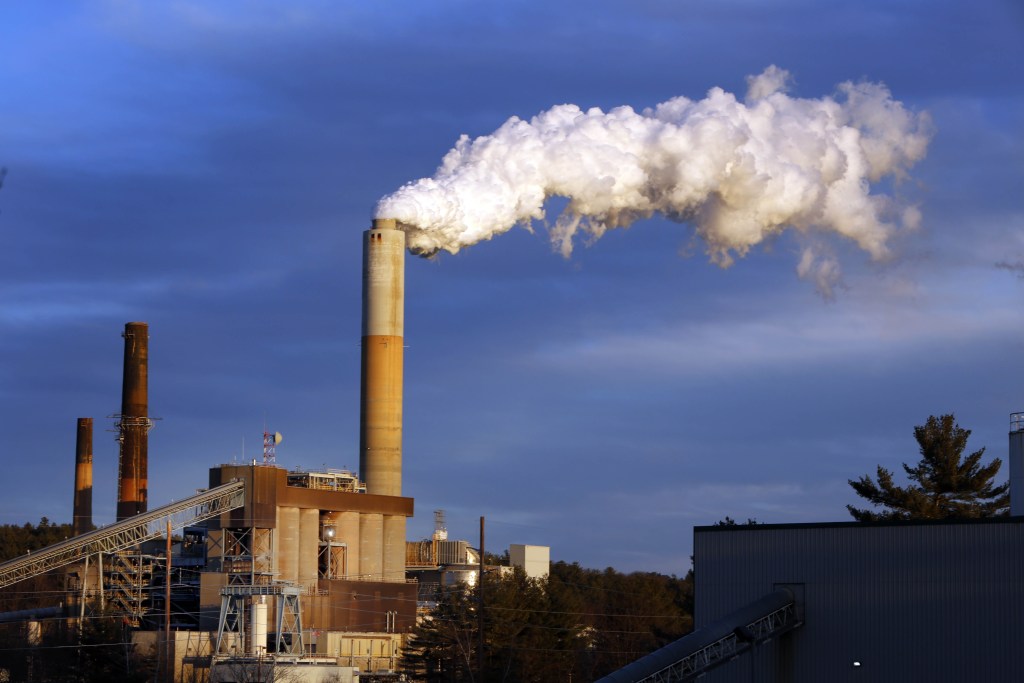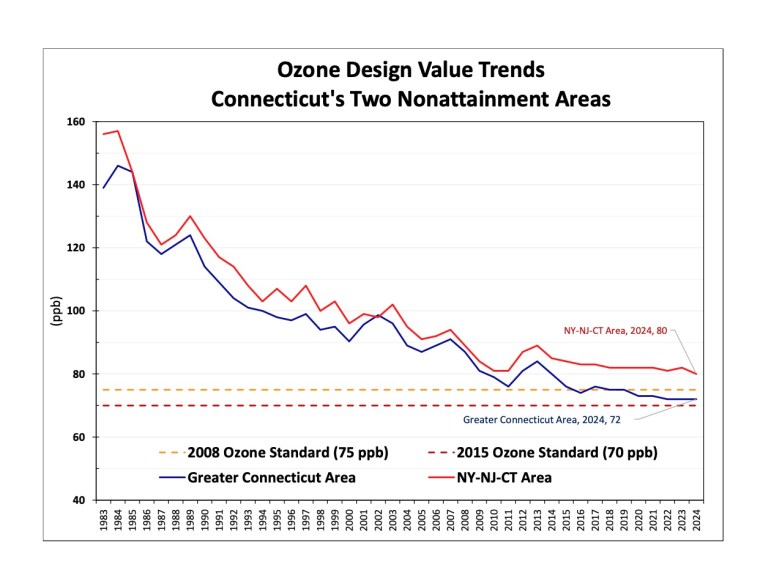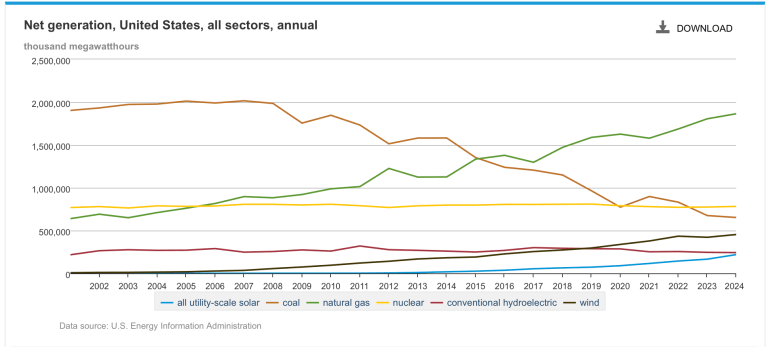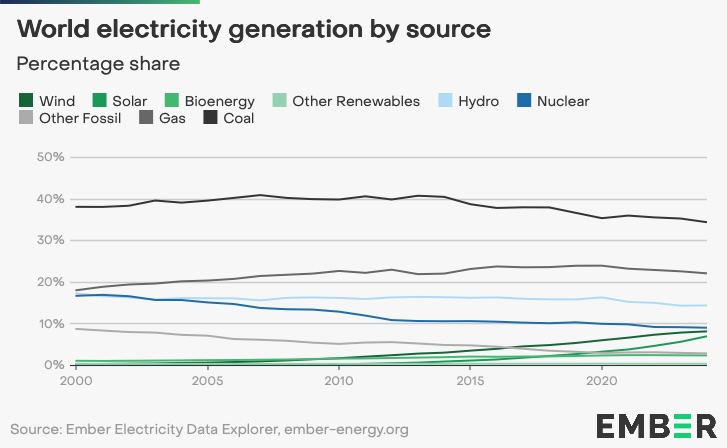How Trump's Coal Policies Will Affect Connecticut, Despite Its Lack of Coal Plants

There remains only one operational coal-powered plant in all of New England, which starkly contrasts with the extensive usage of coal that started roughly 150 years back. This particular facility—the Merrimack Power Station located in Bow, New Hampshire, situated slightly below Concord—is still functioning. is scheduled to shut down in June 2028 .
Therefore, it follows that President Donald J. Trump’s situation is as such. latest batch of presidential directives , aimed at increasing the utilization of coal for power generation and reviving a faltering industry in the U.S., might prompt little more than a dismissive reaction from the area.
Not from Connecticut.
More so than any other state located east of the Mississippi River, Connecticut has consistently struggled with subpar air quality. This issue largely stems from pollutants released by power plants situated across the nation’s midsection—particularly the over 200 facilities that burn coal, which represents one of the most environmentally damaging methods of generating electricity.
Paul Farrell, who leads planning and standards for the Air Division at Connecticut’s Department of Energy and Environmental Protection, DEEP, is definitely not dismissing the issue.
According to modeling conducted by the Environmental Protection Agency, it was indicated that during Connecticut’s most severe instances of ozone contamination—referred to as persistent smog and poor quality air occurring mainly in summertime—the majority of incoming air entering the state reaches with pollutant concentrations between 90% to 95% over the federally established thresholds.
We understand that pollutants travel long distances from the Midwest, Western states, and even Texas," he explained. "These contaminants mix with vehicle emissions traveling along the I-95 corridor, intensifying the issue directly above New York City. This accumulation of pollution then drifts into our state.
Indeed, the just-released 2025 Report on the Condition of the Air as per the rankings provided by the American Lung Association, Southwestern Connecticut is listed as experiencing 16 th highest levels of ozone contamination nationwide . Four out of Connecticut's eight counties have received failing grades for ozone levels. , three get D grades and one earns a C.
The state experienced 23 days with elevated ozone levels last year. above allowable federal standards. That’s the highest number recorded in recent years. Only the northern and eastern parts of the state meets 2008 ozone standards . None of the areas within the state comply with the more stringent 2015 regulations.

The Trump administration has exempted approximately 70 coal plants To keep operating under the present emission regulations for at least another few years after 2027, when stricter ones will be implemented. rules introduced by the Biden administration regarding emissions are set to begin. The facilities that are excluded include numerous power plants located in the Midwest and Mid-Atlantic regions, which are situated directly upwind from Connecticut. Additionally, several of the nation’s most polluting plants are also exempted.
New Hampshire’s Merrimack facility is included in this listing—a puzzling inclusion even to its operator, Granite Shore Power. They did not seek an exemption since they already possess one. Given that the plant’s shutdown is scheduled for 2028, the authorities decided against mandating costly pollution-control improvements for such a brief operational timeframe.
"Without this prior exemption, Merrimack Station would have had to allocate hundreds of thousands of dollars for monitoring equipment at a facility that is set to close just months afterward," stated a spokesperson from Granite Shore via email.
The spokesperson stated that there are currently no plans to postpone Merrimack’s closure, which the Trump administration’s measures would additionally permit. The initiative to convert the facility into a solar and energy storage site remains on track, and the coal operations will keep adhering to emission regulations.
In March, Environmental Protection Agency Administrator Lee Zeldin announced A set of 31 environmental rules that the administration aimed to review and potentially rescind. Included among them was one that stood out. tighter restrictions on mercury and toxic air pollutants, or MATS, for coal- and oil-fired power plants. The standards he targeted were completed a year ago by the Biden administration And it would have reduced emissions of mercury, which is linked to various human health issues, as well as carbon dioxide—the primary driver of climate change—nitrogen oxides, fine particulate matter, and multiple metals.
What I anticipate is that this two-year extension marks only the initial phase of a dual-stage strategy orchestrated by Lee Zeldin, leading to these facilities not having to implement further pollution reduction measures," stated Joseph Goffman, who served as the assistant administrator for the EPA Office of Air and Radiation under the Biden administration. He mentioned that Zeldin’s move to "reevaluate" the MATS regulation indicated quite clearly and unmistakably that he aimed for the reassessment process to ultimately lead to the complete repeal of those regulations.
Extending protections for coal comes as part of various regulatory changes and reassessments suggested by the Trump-era Environmental Protection Agency, which may affect the air quality in Connecticut.
One of the most alarming aspects is the potential reassessment of the Good Neighbor Plan, which would require 23 states located upwind of Connecticut to decrease the cross-state movement of air pollutants emitted by power plants and various industrial facilities. It is presently subject to a stay that the Supreme Court issued last June. When the justices returned it to the lower courts, the federal Clean Air Act, which has been in place for over 55 years, includes a "good neighbor" clause aimed at restricting the cross-state movement of air contaminants.
Someone else might reassess the criteria for motor vehicle exhaust emissions. The Biden administration has imposed stricter regulations on cars, as well as light and heavy-duty trucks. This development has caused an even greater concern for Farrell from DEEP compared to the potential extended emissions from coal plants.
“There is no question that the most significant effect on public health and air quality would result from the EPA substantially weakening the vehicle emission standards,” he stated. Transportation contributes to the majority of Connecticut’s pollution and ozone issues—around 67% of it. This is largely due to the fact that the area has phased out coal usage.
To tackle transportation issues, we require a dedicated federal ally," Farrell stated. "Unless the federal government manages federal resources that surpass the authority of any single state, achieving our air quality targets for ozone is unattainable.
The executive move by Trump could pave the way for new coal facilities. However, the idea that the area might revert to using coal—either as a secondary option or within one of the current multi-fuel-capable power stations—is not gaining much support locally.
“Absolutely not,” said Dan Dolan, president of the New England Power Generators Association. “No. And I can underline that and an exclamation point. No. The dual fuel facilities that do exist are now gas and oil.”
The only exception in the region is the Merrimack Plant and its sister plant – the Schiller Station in Portsmouth, N.H., which no longer operates and will be redeveloped as a battery energy storage system.
"I don't foresee a future for coal in New England after those facilities shut down permanently in the coming years," Dolan stated.
In the late 1990s and early 2000s, New England started significantly reducing its use of coal. Most of these facilities have since shut down, except for Merrimack; this includes the Bridgeport Harbor Station as well as the Salem, Brayton Point, and Mount Tom stations located in Massachusetts.
Coal usage is generally decreasing. Since 2007, its employment for electricity production in the U.S. has dropped roughly 67%, as per information from the Energy Information Administration. It surpassed natural gas a decade back and currently stands at approximately one-third of what gas accounts for.
Over the past few years, coal consumption has dropped beneath nuclear energy levels, while wind power is rapidly catching up. Hydroelectric and solar energies aren’t far behind either. Last year marked the first instance where wind and solar together surpassed coal usage. based on information from the energy think tank, Ember .

The primary cause of coal's decrease in the U.S. is often attributed to a single factor: it has become less competitive due to affordable natural gas from the fracking boom that began roughly in 2005.
“This was not the U.S. government saying ‘shut down these coal plants,’” said Michael Oristaglio, an energy expert at Yale University who founded the Energy Studies Multidisciplinary program and more recently is with the Carbon Containment Lab at Yale. “This was utility, power company owners basically looking at it and saying, ‘does it make sense to build coal or even to use coal anymore? You can convert a coal plant to natural gas.’”
Various studies indicate that coal-fired plants rank as one of the pricier options for electricity generation. Additionally, they take longer to begin operations compared to natural gas facilities, which makes them less ideal for urgent, or "peaker," power needs.
"I can picture those who operate these older facilities thinking, 'Okay, we now have some additional flexibility to keep running them,' " Oristaglio stated. However, he doesn't foresee any new coal plants being constructed.
Although the U.S. possesses the biggest coal reserves globally, China remains the leading nation both in terms of building and utilizing coal-fired power plants, including those constructed abroad. According to Oristaglio, recent additions to Chinese facilities often include carbon capture technology along with filtration systems which might not prove as beneficial for America’s significantly older plants. Interestingly enough, China leads all countries in the development of large-scale solar energy projects as well.

However, amid the emphasis on economics and environment, one critical aspect frequently neglected is the disproportionate impact of health issues caused by emissions from coal-fired power plants. According to research featured in the journal Science, between 1999 and 2020, particulate matter originating specifically from coal was linked to over twice as many fatalities in the U.S. compared to similar fine particles coming from all other sources combined.
However, coal contains numerous additional pollutants, and their effects build up over time, as stated by Goffman, the ex-EPA official.
"What's crucial for public health is that collectively and concurrently, individuals are subjected to various contaminants, be it from fine particulates, mercury, other airborne toxins, or ozone," he explained.
What we're aiming for is better public health results," said Emma Cimino, DEEP’s deputy commissioner of environmental quality. "So I believe this frequently gets overlooked. The focus on air quality is actually all about improving public health.
While DEEP points out that air pollution in Connecticut is vastly diminished from what it was decades ago, with so many rule rollbacks under consideration, the concern is that the strains on health might become more noticeable.
“As you start to see those tools disappear or be pulled back or even threatened, I think it’s possible that the progress slows,” Cimino said. “Hopefully it doesn’t reverse, but certainly it puts the region on a much slower track to meeting our air quality standards.”
Farrell from DEEP concurred. "Ultimately, our main aim is to emphasize that this initiative revolves around public health," he stated. "We require a comprehensive approach here. It's not solely about regulating power plants; nor is it exclusively about controlling vehicles or industries. Every sector must play its part in finding a resolution."
I believe people might have overlooked environmental and public health concerns, and we should not find ourselves in a situation where we only spring into action after witnessing something like rivers catching fire once more, and then exclaiming, 'hold on – this must come to an end.'
0 Response to "How Trump's Coal Policies Will Affect Connecticut, Despite Its Lack of Coal Plants"
Post a Comment